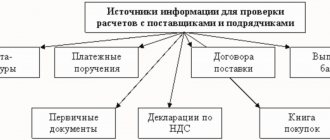Introduction
The economic activity of any enterprise is impossible without cash payments. Payments are usually made through the company's current account or through its cash desk.
Carrying out economic activities, an enterprise is faced with the need to make payments both within the enterprise itself and outside it. Internal settlements are associated with the payment of wages and accountable amounts to employees, dividends to shareholders, etc. External settlements are determined by financial relationships regarding the supply of products, performance of work, provision of services, purchase of raw materials and supplies, payment of taxes, contributions to extra-budgetary funds, receipt and repayment of loans etc. Modern enterprises and organizations around the world are gradually abandoning paper money circulation and switching to the banking system. Accounting for transactions on a current account is much simpler than in a cash payment system. In addition, there are a number of other advantages of this currency storage and processing system. Therefore, the topic of accounting and analysis of funds in current accounts is relevant.
The purpose of the work is to study the features of accounting and analysis of funds in a current account. To achieve the goal, the following tasks are set:
1. Identify the features of accounting for funds in a current account.
2. Analyze the basic principles and forms of non-cash payments.
3. Study analytical accounting and financial planning.
The object is the financial and economic activity of the enterprise, the subject is the accounting of funds in current accounts.
The theoretical basis of the work consists of textbooks and teaching aids of domestic scientists on the problems of theory and methodology of accounting and analysis, orders of the Ministry of Finance and accounting regulations.
Payment order
The most commonly used form of non-cash payments is a payment order. With the help of this document, 93% of all mutual settlements are carried out. This document is a written order to the bank to transfer funds located in the settlement, foreign currency, special account of the enterprise, the payee, his credit institution to the account specified in the document. Commodity and non-commodity payments are made using a payment order. The first type includes transfers of funds for services rendered, goods and materials received, advance transfers, repayment of accounts payable, payments for rent, utilities, etc. Non-commodity transfers can be made not only using a payment order. A collection form of payment is possible. Non-commodity payments include the following payments: payments to budgets of various levels, extra-budgetary funds, repayment of loans, borrowings, overdrafts, interest on their use, transfer of funds on account of the share in the authorized capital of the organization, acquisition of shares, bills, repayment of penalties, penalties and imposed fines, etc. The positive aspects of using this type of payment are simplified document flow, the ability to pay for non-commodity payments, and the speed of movement of funds.
Accounting for funds in a current account
The owner of a current account can be any legally registered organization that has one or another property. In order for an organization to be listed in banking systems as a legal entity, it must have a clear management system, maintain accounting records, and have an appropriate package of documentation on registration and the specifics of its activities. There are other criteria that an organization must meet in order to be able to record transactions on a current account.
The organization must provide bank employees with a corresponding application to create the appropriate account. Naturally, without a complete package of documentation, this action will be impossible. As a rule, in order to start recording transactions on current accounts, banks require notarized copies of the following documents: a photocopy of the charter of the enterprise wishing to obtain an account with the bank; constituent agreement or (in the absence of one) agreement on establishment; certificate of registration of an enterprise wishing to begin recording transactions on a bank account. Sample signatures of the chief accountant and the immediate manager of the enterprise, as well as a sample of the seal imprint, must be provided. The enterprise must be registered with the Pension Fund, the tax office and the social security and social insurance authorities.
After registration is completed, the company will be assigned an appropriate account number, to which all financial receipts available in the assets of the company will be transferred. In this case, we mean: the profit of the organization, wages allocated to employees, loans received, and other foreign currency receipts. The number assigned to a legal entity upon registration is placed on all documentation forms of the enterprise. Accounting for transactions on current accounts in banks is carried out in such a way as to ensure recording of the full range of actions performed in relation to monetary assets stored in a particular bank. In this case, we are talking about both the expenditure of money and the receipt of it.
The general algorithm for working with funds in an account includes the following points [4, p. 283]:
1. Receipt can be made on the basis of an appropriate announcement, using the cash register.
2. Payment can be made based on presentation of a check.
3. Transfer of funds to a specific address can be made on the basis of a payment order.
A payment request-order is a document on the basis of which the service provider, through a message from the bank, can demand the transfer of funds by an identified payer (service provider).
1 - Payment order. 2 — Bank statement. 3 - Payment order. 4 - Payment order. 5 — Bank statement
Figure 1 – Payment by payment order
Accounting for transactions on a current account in 2014 ensures not only the security of funds of enterprises and organizations, but also the ease of their use.
Synthetic accounting of transactions on a current account is the recording of movements of funds on an active current account (No. 51) of an enterprise and their documentary support. Thanks to the clear and systematic recording of business activities, the organization is able to carry out [4, p. 286]:
- a clear analysis of the sources of funds received into the current account;
- control of the intended use of the enterprise’s money;
- timely fulfillment of business obligations and calendar budget payments.
Regulation No. 2 of the Central Bank of the Russian Federation, concerning non-cash settlements, obliges the recording of transactions taking place on the company’s account using journals, orders, statements, as well as settlement documents: cash receipts; payment orders; collection requirements. Mandatory details of payment documents are:
The name of the document, its number and full date (indication of the day, month and year when it was issued). Details of the payer and recipient (names, IIN, numbers of settlement, correspondent and sub-accounts, as well as bank data - names and addresses). Indication in numbers and words of the amount transferred. A separate line indicating whether tax is included (or not).
The VAT column is an important mandatory element. If a tax deduction is included, the amount is written down (in numbers and in words). If not included, a mark indicating non-taxation of the payment is placed.
All deposits made through the current account are recorded in a statement (No. 2) plus in order journals.
Synthetic accounting of transactions on the current account reflects circulating debit movements for:
- transfers by the company’s clients (buyers of goods or customers of services);
- obtaining loans; free funds remaining at the beginning of the month (remains);
- cash receipts from the organization's cash registers.
When depositing cash into a current account, it is necessary to fill out an announcement about depositing funds. This is an order from the enterprise, executed in one copy, to accept cash through the cash register using correspondent account No. 50 and indicating the source of receipt. Declaration of the use of cash amounts may be necessary in cases where: the proceeds are surrendered; banking services are paid; contributions are made according to the constituent documents; funds are deposited from depositors, etc. The advertisement has three parts: The top spine is intended for the bank. The middle, which is the receipt itself, remains with the cashier. The lower part is an order, which, together with the bank statement, is also kept by the cashier upon completion of the transaction.
Current credit transactions on the organization's current accounts are reflected in correspondent accounts (registered in journal order 2).
The credit of the account shows accounting for: repayment of debts to the contractor, supplier, etc.; payments of social, pension, tax contributions, as well as interest on bank loan agreements; issuing amounts in cash to the company's cash desks.
It is mandatory to draw up a check signed by the chief accountant and the director of the organization when there is a need to receive money from the current account to the cashier, indicating the intended purpose: employee salaries; benefits; business trips; for household expenses [7, p. 105].
A checkbook is a strict accounting matter. The counterfoil of the check contains the same details as the main part. It is left so that cash transactions can be confirmed in the accounting registers.
Synthetic accounting for a current account often requires the execution of one or another order. A line is indicated indicating whether the payment is subject to VAT deduction or not.
The functional purpose of the instructions may be to instruct the bank to transfer funds for the following purposes: to pay for the services of suppliers of goods; pay intermediaries for services rendered; pay interest on loans, etc.
The payment request may also contain requirements for the payment of funds through the bank, in accordance with signed contracts and agreements for the supply of goods or provision of services. That is, it is drawn up by the creditor (recipient) for the debtor (payer).
The requirement provides for: indication of terms and conditions for payment; special purpose; details of the contract for the supply of goods or provision of services; attached documented facts of receipt of products or work performed (as well as their list and dates); a column indicating the date of receipt of the claim by the debtor.
The document is valid for ten days, starting from the next working day from the moment of signing. If the operation does not extend beyond the scope of one credit institution, the order has three copies. Otherwise, more.
To record the movement of non-cash funds of the organization, 51 accounting accounts are intended.
His analysis shows that this account is active and always has a debit balance. The debit of account 51 is intended to reflect the receipt of non-cash funds to current accounts (the asset increases), the credit of account 51 reflects the write-off of funds (the asset decreases).
The main entries for account 51 are presented in tables 1 and 2.
Table 1 – Typical transactions for the receipt of non-cash funds to a current account
| Debit | Credit | the name of the operation |
| 51 | 62 | Payment or advance comes from the buyer |
| 51 | 50 | Cash deposit from the company's cash desk to the bank |
| 51 | 75 | Non-cash contribution to the authorized capital |
| 51 | 67 | Obtaining a long-term (short-term) loan |
Funds are written off using a payment order. It is drawn up in two copies and submitted to the bank. A bank mark is placed on one copy indicating that the order has been accepted, after which it is sent back. When money from the cash register is deposited into the current account, an advertisement is issued for a cash deposit.
Table 2 - Typical entries for the disposal of non-cash funds from a current account
| Debit | Credit | the name of the operation |
| 60 | 51 | Payments to the supplier |
| 60 | 51 | Withdrawing money from the account to the cash register |
| 75 | 51 | Dividend payment |
| 67(66) | 51 | Repayment of loan (credit) |
Movements in the current account according to payment orders are accepted or not accepted.
That is, the buyer may have a deadline to notify the bank of his refusal to pay for the product or service. Preliminary acceptance does not exceed three days. After this time, the amounts are credited to the organization’s account. Undisputed write-offs can be made based on collection orders. It is drawn up in the same way as a demand, but indicating the basis for indisputability: official penalties from regulatory authorities or, if the bank has the right to carry out similar actions on the company’s current account [10, p. 224].
The procedure for making non-cash payments by individuals
In accordance with Article 861 of the Civil Code of the Russian Federation (hereinafter referred to as the Civil Code of the Russian Federation), settlements with the participation of citizens not related to their business activities can be made in cash without limiting the amount or by bank transfer.
Non-cash payments are made through banks and other credit organizations in which the corresponding accounts are opened, unless otherwise follows from the law and is not stipulated by the form of payment used.
For non-cash payments, payments by payment orders, letters of credit, checks, collection payments, as well as payments in other forms provided for by law, established in accordance with banking rules and business practices applied in banking practice are allowed.
Based on Article 862 of the Civil Code of the Russian Federation, the parties to the agreement have the right to choose and establish in the agreement any of the specified forms of payment. General provisions regarding settlements are determined by Chapter 46 of the Civil Code of the Russian Federation. At the same time, non-cash payments can also be regulated by banking rules, in connection with which you should pay attention to the “Regulations on the procedure for making non-cash payments by individuals in the Russian Federation”, approved by the Central Bank of the Russian Federation on April 1, 2003 No. 222-P (hereinafter Regulation No. 222-P), which has been in effect since July 1, 2003.









